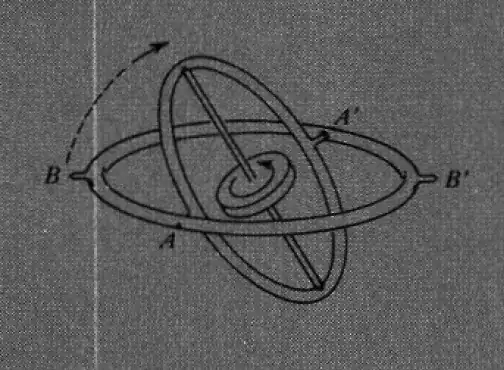In A.P. French's Newtonian Mechanics, pages $684$ and $685$ , the author said the following about gyroscopes,
If a gyroscope, mounted in its gimbal rings, is set spinning about a horizontal axis, and the outer gimbal is rotated in a horizontal plane, then the inner gimbal ring, carrying the flywheel, tilts up out of the horizontal plane in which it, too, first lay, and after a few oscillations, damped out by friction, the axis of sping of the gyroscope settles down along a vertical direction.
This behavior can be qualitatively understood if one recognizes that the pivots on which the inner gimbal is mounted can supply torques about the vertical direction and about the spin axis of the flywheel, but not about the axis connecting the pivots themselves. This last fact, implying conservation of angular momentum about the axis AA', can be used to explain why the tilting begins. The attempt to rotate the spin axis of the gyroscope in a horizontal plane would, by itself, introduce a component of angular momentum along AA'. The tilting motion provides an equal and opposite angular momentum component that keeps the angular momentum about AA' equal to zero.
The torques that can be supplied via the forces at A and A' are able to perform the main task of canceling out angular momentum about the axis BB' and creating angular momentum about the vertical axis, corresponding to the reorientation of the spin angular momentum $I\boldsymbol{\omega}$ from horizontal to vertical. This process will continue until the axis of the flywheel is fully aligned with the axis of the torque.
I apologize for the length of the excerpt, I tried to give as much context as possible.
Question 1: Where does the torque that rotates the inner gimbal come from if the pivots themselves cannot provide this torque?
Question 2: Which torque exactly is the author referring to in the last paragraph?

